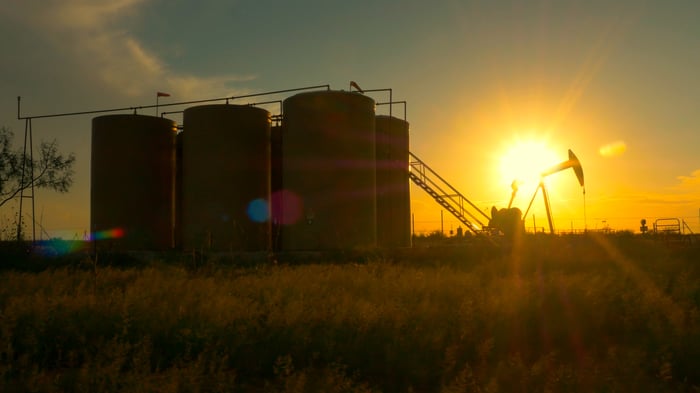Devon Energy (DVN 2.91%) has spent the past few years transforming into a shale-focused company. It has sold several noncore assets and used the proceeds to pay down debt, buy back stock, and expand its shale-focused business. While the company has a couple of legacy assets that it still plans to unload, the new Devon is emerging as a high-octane oil and cash flow-generating machine, which was quite clear during the first quarter.
Drilling down into the results
|
Metric |
Q1 2019 |
Guidance or Expectations |
Difference (at the Midpoint) |
|---|---|---|---|
|
Total production |
529,000 BOE/D |
478,000 to 514,000 BOE/D |
6.7% |
|
Total production "new" Devon |
308,000 BOE/D |
272,000 to 290,000 BPD |
9.6% |
|
Oil production "new" Devon |
138,000 BPD |
125,000 to 130,000 BPD |
8.2% |
|
Core earnings per share |
$0.36 |
$0.28 |
28.6% |
BOE/D=barrels of oil equivalent per day. BPD=barrels per day. Data source: Devon Energy.
Devon Energy unleashed a torrent of production during the first quarter thanks to strong results in its U.S. shale assets. Total output from the "new" Devon came in a stunning 27,000 BOE/D above the midpoint of its guidance range and was up 24% year over year. Meanwhile, high-margin U.S. oil production was 8,000 BPD above the top end of its guidance range and was 24% higher than last year's first quarter.
The star performer was the company's position in the Delaware Basin. Total production from that region rocketed 76% year over year to an average of 107,000 BOE/D. Some highlights were the prolific results of five Cat Scratch Fever wells, which delivered impressive initial 24-hour production rates of more than 10,000 BOE/D.
Devon also did a good job of managing costs during the quarter. Lease operating expenses declined 10% from the fourth quarter, which was below the low end of its guidance range. In the meantime, general and administrative costs have fallen 23% over the past year.
That combination of high-end output and low-end costs enabled Devon to exceed analysts' earnings expectations quite easily.

Image source: Getty Images.
A look at what's ahead
Devon's strong first-quarter production results have the company on track to produce more from the assets it will retain this year than initially expected. That led the company to raise its full-year U.S. oil growth outlook from 15% to 17% versus 2018's average. It can achieve that faster growth rate without increasing capital spending, which will remain between $1.8 billion and $2 billion at its retained assets.
Its plans also include returning cash to shareholders. The driller has already repurchased $4 billion of its stock, retiring 20% of shares outstanding. It intends to buy back another $1 billion by year-end, and recently increased its dividend by 13%.
Devon is currently evaluating several methods to exit Canada and the Barnett shale by the end of this year so that it can focus entirely on the assets of the "new" Devon. Among the options it's considering is selling them to a third party or spinning the assets off to investors. Its goal is to use this process to reduce debt by another $3 billion.
Devon's drilling machine is only getting started
Devon Energy controls prime positions across four top-tier U.S. shale plays, which should fuel strong production and cash flow growth in the coming years. At $46 a barrel, the company can generate enough cash flow over the next three years to grow its output at a 12% to 17% compound annual rate. This low breakeven level sets it up to generate a gusher of free cash flow above that level -- it's on track to produce more than $3 billion if oil remains in the mid-$60s. That would give the company even more money to return to shareholders via a higher dividend and expanded repurchase program. It's one of the many reasons why Devon's among the best oil stocks to buy right now.





